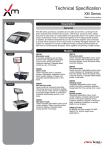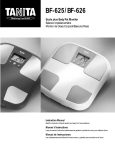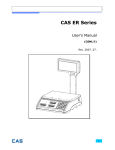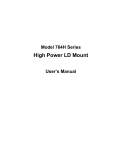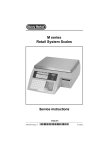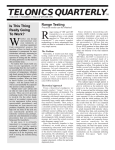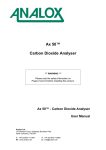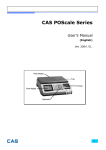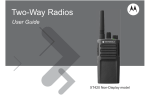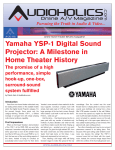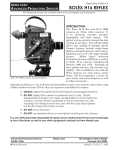Download ABR35-000556-AC XT Tech Spec - English.indd
Transcript
Technical Specification XT Series Retail printing scales XT100 Description General The XT Series provides a complete set of scales and printers, covering the different requirements of fresh food counters, self-service, pre-pack areas and point-of-sale areas for supermarkets and speciality stores. The scales may be used in stand-alone mode or networked together to form departmental systems. In addition, the different departments can be networked together and connected to a back-office computer to form store-wide or centrally-managed networks. The scales can operate in a number of different modes, printing individual labels for each item or combining the shoppers’ items together and printing a single receipt. Crucially, the scales are based on PC architecture, running Windows or Linux operating systems. This gives them full flexibility for integration of third-party devices and for running third-party software. XT200 Models XT100 Monobloc scale A compact weighing and printing terminal with integrated adjustable colour touch vendor and colour customer displays. Cassette label/ receipt printer in the base. XT400 XT101 Monobloc scale As the XT100 but without rear display and with external display connector, enabling connection of a large, thirdparty external display. XT200 Tower scale Tower mounted colour customer display. Adjustable, integrated colour touch vendor display on base unit. Cassette label/receipt printer in the base. XT400 Two-piece scale Tower mounted adjustable colour touch vendor display. Tower mounted colour customer display. Cassette label/receipt printer in the base. XT410 Two-piece scale Tower mounted adjustable colour touch vendor display with integrated receipt/ liner-less printer. Tower mounted colour customer display. XT420 Two-piece scale Tower-mounted, adjustable colour-touch vendor display with integrated receipt/ liner-less printer. Tower-mounted colour customer display. Cassette label/receipt printer in the base. XT300 Self-service scale Large, column-mounted customer touch-screen display providing a flexible, easy-to-use and adaptive customer interface for self-serve departments. Keys can be configured to provide optimally-sized keys. Cassette label/receipt printer in the base. 1 XT Series Technical Specification At-a-glance XT Series specification Dimensions Feet locations (spacing w x d) Approx. 280 x 230mm (w x d x h) • • • • • • Mono Mono + tower Self-service Two-piece - base printer Two-piece - raised printer Two-piece - dual printer XT100 408 x 466 x 156mm XT200 408 x 493 x 528mm XT300 408 x 343 x 610mm XT400 408 x 343 x 528mm XT410 408 x 343 x 528mm XT420 408 x 343 x 528mm • Standard capacities 15kg AVR • Options 30kg x 5g on XT100 and XT200 • Out-of-level compensation Yes - Valumax • Protected metrology unit (service electronics without need to restamp/break seals) Yes Power • Power supply - rating & type 100-240VAc, 50/60 Hz, Internal Technology base • Processor Via Nano, 1.3 GHz Memory • System memory Up to 2GB (1GB default) • Video RAM Up to 256MB • Hard disk 160GB • Inter-scale network Ethernet, 10/100/1gb base-T auto switch • Number of scales per network Limited by system performance only • Networking host l/f Ethernet as standard • Number of host networks/servers Unlimited RF comms • RF: inter-scale and host Optional: internal USB WiFi device 802.11b/g/i/n Displays • Operator display 10.2” colour TFT SVGA 1024 x 600; resistive 5-wire touch screen; mounted on tiltable fixture • Customer display 10.2” colour TFT SVGA 1024 x 600 on XT200, 400, 410, 420 models Metrology Networking: inter-scale Networking: Host l/f 7” active colour WVGA TFT: 800 x 480 on XT100 model Interfaces 5 x USB interfaces (3 external) 2 XT Series Technical Specification At-a-glance XT Series specification (continued) USB memory device support Yes Sound Full sound system with speaker Label/receipt printer Label/receipt printer general Raised Raised printer printer (XT410, (XT410, 420) 420) Modes • Cassette Yes, single action • Label/receipt roll diameter 120mm • Max print width 70mm • Edge-to-edge printing @ max print width Yes • Backwind Yes • Max paper width 72mm • Maximum print length 300mm • Print speed 150mm/s • User-replaceable print head Yes • Easy-to-load graphics on labels save on pre-printing Yes • High-resolution grey-scale printing Automatic grey-scale printing from any black and white or colour graphic • Print-head monitoring/warning Yes - ‘Codechecker’ - so only scannable barcodes are produced • Roll diameter 100mm • Max print width 56mm • Max paper width 60mm • Print speed 100mm/s • Linerless adhesive paper Yes, standard • Drop-in paper loading Yes • Label Yes • Receipt Yes • ECR Yes, full • Pre-pack Yes 3 XT Series Technical Specification Hardware Processor & memory XT Series uses an X86 Via Nano processor running at 1.3GHz. There is up to 2GB of shared system memory, 256MB of video RAM allocated, a 2GB SD Card and a 160GB hard drive. The number of PLUs that can be stored varies with the number and lengths of various texts stored, but the user is never likely to approach the limits of the memory available. Weighing All models are available as 15kg AVR which gives 2g increments to 6kg and 5g increments from 6 to 15kg. XT100 and XT200 are optionally available as 30kg x 5g. Every XT has the loadcell metrologically sealed to enable the main components outside of the weighing mechanism to be serviced without breaking any weights and measure seals. Valumax technology Valumax is a patented technology unique to Avery Berkel Xtra scales. It automatically compensates for out of level conditions that frequently occur with weighing scales. When the scale is out of level it underweighs, giving a weight which is lighter than it actually is. Valumax compensates for this and corrects the weight to its real value. This feature can save the retailer many thousands over the lifetime of the scale and also ensures that the scale always complies with the levelling requirements of Weights and Measures authorities. Touch screen & displays The user interacts with the XT using the 10.2” TFT touch-screen display. This uses five-wire resistive technology and is thus extremely robust. The screen is specifically designed to keep the vulnerable touch-sensitive areas away from knives or other sharp implements often used to scrape out accumulated detritus or residue. All functions such as numeric keypad, fixed function keys and programmable keys (operator, products etc.) appear on the touchscreen display. The touchscreen and display housing can be set at a variety of angles from near vertical to near horizontal. This enables reflectionfree viewing and also easy adaptation to all heights of counter in use around the world. The XT100 customer display is a 7” TFT in WVGA format with 800 x 480 pixels. XT200, 400, 410 and 420 models use a 10.2” display with the same specification as the vendor side. Printing Most XT models make use of a label or receipt cassette printer mounted in the base. The XT410 has a receipt cassette printer mounted in the headwork and the XT420 has both the head-mounted receipt and lower-mounted label/ receipt cassette printer. Label/receipt printer This is a heavy duty printer with dual motors, one driving the paper feed and one the paper take-up. The cassette system is single-action removal, meaning that to remove the cassette you need do nothing more than unlatch the red lever and withdraw the cassette. The print head is automatically disengaged. Additionally, the cassette, side panel and ticket mouth are all one piece, meaning that there is nothing to lose or remove – the scale will always be complete and look its best. The ticket mouth at the front can be flipped down, allowing any paper jam to be easily cleared with the cassette in place. The cassette itself features devices for ensuring the paper roll is retained when it is out of the printer, and a paper guide. These, together with the take-up reel tensioner, are coloured red so the operator can easily identify which parts can or may need to be adjusted. Spare cassettes are available in order that when one runs out, it can be exchanged in seconds with a pre-loaded replacement ensuring near-continuous service at the counter. The printer contains several sensors that inform if the cassette is home, the latch shut properly, etc. This, coupled with on-screen instructions ensures that the cassette is always replaced properly and the latch pushed home. A label-taken sensor is fitted as standard to every Xtra scale detecting when the label has been taken in order that the label roll can be rewound slightly and thus printing of the next label starts exactly on the edge of the paper. This ensures the entire label can be printed on and reduces paper costs. Print heads are hard-wearing, 70mm wide and are capable of printing up to 16 scales of grey for more realistic image printing. This also means that images used on labels do not need to be dithered or reworked prior to incorporation in the label design. The print heads also benefit from patented Avery Berkel Codechecker technology that monitors the condition of the print head, lengthens its life and helps avoid prolonged queues at checkouts due to non-scanning barcodes. This is also used to display the print-head status in the status bar at the lower edge of the vendor display. Print heads are easily replaced by the user, sliding simply outwards from the main carrier. Receipt printer XT410 and 420 models have a receipt printer in the upper keyboard/display housing. This also makes use of a cassette system for fast loading of receipt paper. As standard, the printer is equipped with a special roller enabling use of liner-less adhesive paper. The print head is integrated into the printer and is exchanged by replacing the low-cost print mechanism. Dual printer The XT420 has both a cassette label/receipt printer in the base and a receipt/linerless printer in the upper keyboard/display housing. A common setup is to use the scale for both labels and receipts, printing labels at the cassette printer in the base and receipts on the upper printer. 4 XT Series Technical Specification Interfaces XT scales have a total of 5 USB interfaces. Four of these are located beneath the scale with one intended for a USB WiFi device and the remaining three for peripherals such as scanners or cash drawer. The fifth USB socket is located in the printer compartment and is intended for connection to a USB mass storage device for local down and upload of scale data or transfer of a scale image. The scale has an internal mini PCIe connector, not currently used. Inter-scale & host networking Each XT has 10/100/1Gb Base T Ethernet networking as standard. This enables connection in an interscale network as well as connection to a host back office or head office system. The inter-scale networks are configured in a Client/Server arrangement with all scales sharing the same Ethernet ‘port address’. Additionally, scales can be grouped in “peers” whereby price changes made on one scale are sent to the remaining peers in the network. Performance is the only limiting factor on the number of Clients a Server can support. Resilience is provided by Client scales, which use the Server database by default, reverting to using their own database if the network connection is lost. When scale network connectivity is restored, the item and transaction data is re-synchronised across the network. Host connected scale networks can be arranged as ‘Multi-Server’ where each scale operates as an independent Server, each having a direct connection to the Host device. Alternatively the Scale networks can operate as Client Server with the Server being responsible for all Host data transfers. Client Server operation is required for ‘floating’ transaction systems used for both ‘Receipt’ and ‘Add’ modes. In addition, host names of up to 100 characters can be specified for a particular scale for use in conjunction with DHCP and DNS. MXTool can be used for the support of scales within a store network, enabling file and scale maintenance. This can also be achieved remotely, away from the store site, network access and infrastructure permitting. WiFi communications USB WiFi devices can be plugged in to the underside of the XT and used for wireless RF communication instead of wired Ethernet. The supported standard may vary from one device to another but as a minimum, 802.11n with back compatibility to 802.11b should be supported. Note that this is dependent on the device and not the scale. Software Operating modes Label mode Label mode is used generally for single item, weighed or nonweighed transactions. The system can be set to print on request or automatically once the weight is steady. Self-service mode This is a variant of Label Mode, used mostly on fresh produce departments where the public are expected to weigh and label their own produce. The scale will prompt the user to select the item from the large self service keyboard and place the item on the scale. The label is printed as soon as the weight is steady. This mode is usually used with the XT300, but it is also possible with the XT101, the compromise being the smaller screen size of 10.2” versus the 18.5” of the XT300. Pre-pack This mode enables labels to be automatically printed for a selected item upon the weight on the pan changing. An item is selected in the standard way and then fixed with a label being printed each time the weight changes and returns to a steady weight again. The label taken sensor ensures that labels are not issued before the last one has been taken. Non-weighed items can have the labels streamed if required – ie. many labels are printed for the same non-weighed item in one run. This is typically used to quickly label bakery items. Label formats Label Formats are fully flexible in layout and can be pre-set for a scale or for each individual item. The label designer in the MX series of software products can be used to modify the label formats. Up to 50 fields of information can be printed on each format. Fields consist of legends used for variable data such as dates, weight, weight per kg etc, sales messages with fixed text data set against a particular PLU and logos or graphics. All of the above can be rotated to 90, 180 or 270° and the entire label can also be rotated to 0, 90 or 180°. Printing can be set to individual sticky labels where the gap between labels is sensed or continuous sticky paper which is torn off against the tear bar. Labels on continuous sticky strip will automatically print to the correct length, whereas those on individual labels will need to be designed to fit on the space available. Receipt mode Receipt Mode enables a list of transactions to be assigned against an operator and these to be totalised. Additionally, when the scales are networked together, operators may float across several machines, adding transactions as they go. An unlimited number of operators may be live on each scale network at any one time with name and number printing on the receipt subject to system performance. Receipt formats are largely fixed with a flexible header and footer at the top and bottom. Seven different receipt formats are available although some of these are countryspecific and some countries specify that a certain layout or terms must be used. 5 XT Series Technical Specification The void function enables the cancellation of a complete sale or individual transactions prior to closing and printing the receipt. Sales can be limited to those from a specific department by including the Department or Group in the receipt barcode. Receipts can be printed on continuous adhesive paper or receipt (non-adhesive) paper on the cassette printer and on receipt paper or linerless adhesive printer on the upper receipt printer on XT410 and 420 models. All receipt transactions can be stored and collected and individual receipts reprinted – see the Audit section for further details. These can be reopened and voided as a whole or have individual transactions voided, subject to the feature being enabled Receipts can also be set up to print a copy immediately after every original. System data System Data is that which applies to an entire Xtra Series network. This data can be created and edited on any scale in the network, through one of the MX software packages or from a third-party back office using an MX data integration product. Product Product consists of numerous data elements, all editable when in manager mode. This covers department and group to which the PLU belongs, the PLU number and description together with other associated text, price and associated information, promotional information, date information, sales messages, logo, barcode information, traceability information, nutritional information and keyboard location. A handheld scanner can be used to assist in quickly creating or editing PLUs directly on the scale when in manager mode. Idle time adverts The XT can be configured to display a series of adverts – text, image or video whenever the scale has had no key press or weight change for a user-defined period of time. The playlist is defined from media held on the scale and will cycle around back to the beginning when the end is reached. If it is cut short, it will resume with the next advert in the list after the user-defined period of no interaction. Nutritional information Each PLU can be provided with nutritional information if required. A list of nutrients needs to be programmed first, against which, values are then programmed in the PLU records. Nutrient information can be programmed to print either on the same product label, or on a separate label. As well as being able to print individual nutrient values per product, the standard measure (normally 100g) values and RDA values can also be printed. Departments The number of departments is unlimited, but in practice is constrained by system performance. A minimum of 100 departments is easily achievable. All products are allocated to a specific user-defined department. Tables The following data tables are used by the scales as data sources, The data stored in tables is referenced from other parts of the software when required. Tax Tax rates can be programmed, with up to two tax rates being assigned to PLUs. Tares Tare weights can be programmed which can be assigned to PLUs for use as preset tare values or assigned to keys for recall in normal operating mode. A tare interlock can be used to ensure a label is only printed if a tare has been selected. Tares may be configured as selfcancelling (one-shot) or fixed. Additionally, semi-self-cancelling, cumulative or proportional tares may be programmed. Discount tables Discount rates are programmable with a maximum of 16 displayed characters for describing the discount rate. The discount value may be disabled or entered as a percentage or value. The security level is applied for discount protection when operating the scale in sales mode. Add label You can assign one of the standard label formats to be printed as the add label format, or this can be set to print in a receipt style. Barcode types & formats XT supports the following barcode types: • • • • • • • • • • • • • • • EAN 13 EAN 13 Scandinavian. EAN 8 UPC 13 UPC12 EAN 128 Code 128 Code 39 Code 39 extended PDF 417 GS1 Databar expanded GS1 Databar stacked GS1 Databar14 GS1 Databar limited ITF14 The following data may be encoded in the barcode: article number, price, weight, trace code, operator number or department number, group and transaction number. Weighing and traceability type application identifiers are supported by the EAN 128 barcode format. Barcodes may be programmed to print on receipts, labels, talons or combinations thereof. The add label barcode format is that which is programmed for that machine’s receipt. Each PLU may be programmed to use one of the configurable barcode formats. Header message (sign on) (for receipts only) The message printed at the top of receipts can be programmed at any scale and is transmitted to all scales in a system, ensuring all machines print identical headers. The header message may be printed multi-line, across the full width of the receipt. A logo can also be used in addition to, or instead of, the header message and is printed at the top of the receipt. 6 XT Series Technical Specification Footer message (sign off) (for receipts only) The trailer message printed at the bottom of receipts is programmed at any scale and is transmitted to all scales in a system, ensuring all machines print identical footers. The trailer message may be printed multi-line, across the full width of the receipt. A logo can also be used in addition to, or instead of, the trailer message and is printed at the bottom of the receipt. Information labels Information label references can be set up in order to be assigned to PLUs. An information label is programmed with a description, label format number and preferred integral printer. When a PLU is served with an associated information label, in label mode, the information label will be printed after the initial product label. In receipt mode, the information label is printed when the PLU is transacted by the operator key. Information labels can be used for a number of different applications including ingredients, recipes, promotional/merchandising, cooking instructions, coupons and traceability. Vouchers Voucher types can be set up and used in conjunction with a PLU voucher promotion. Each voucher reference needs to be programmed with a description, mode of use (label, receipt or both), expiry date, barcode format, printer from which the voucher should be issued and label format (which provides the voucher layout). Vouchers containing barcodes can then be scanned at the point of sale and depending on the barcode content, can be used to identify the product, voucher price and even expiry date. expiry date. Re-pricing The re-pricing mode is a non-PLU associated method of printing labels, with pricing and barcode information, which are adhered over a product’s original price and barcode information. The re-price function requires setting up with default label information, barcode format, whether packs will be weighed and if totals are required to be stored or not. Traceability XT scales feature comprehensive options for all types of traceability requirements. Different traceability schemes may be individually programmed, allowing associated products to be tracked through their supply chains. Scheme options include the ability to print userdefined trace information, manual or scannable methods of data input and the ability to reproduce ‘traceability passports’. All schemes can be used in either label or receipt modes, allowing counter or pre-pack service operation. Operator roles Each operator can be programmed with varying levels of access to specific functions such as price override, manager mode access, discounts etc. Security log The security log is a report which shows functions that have been carried out above a user-entered security level. For example, a report printed for security level eight would print each level eight and nine function carried out, with the date and time and the name of the operator who performed the function. System functions Audit mode Audit mode records transactions performed on the scale and is activated in Manager Mode. The filtering option allows the operator to select whether transactions should be stored for Label only, Receipt only or Label and Receipt transactions. The server buffer is configurable to store receipt or label transactions in a linear or circular format. Linear can only hold a determined number of transactions and advises the operator when full. Depending on the linear option selected, the operator may or may not override this warning. When overridden, the first transaction stored will be overwritten. If the linear mode has been selected and override is disabled, trading cannot continue until the buffer is emptied by printing the audit report and clearing the transactions. A circular buffer will continuously write over transactions on a first in, first out basis when the memory becomes full. A transaction buffer size can be changed in Service mode, on Installation. Last subtotal When enabled, last subtotal allows operators to recall the value and number of transactions from the last receipt they transacted, to the display. Reprinting of the receipt is possible by pressing the ‘Total’ key. Note that this receipt is marked as a duplicate copy. Pre-pack PLU lock Dependent upon the setting of the pre-pack PLU lock, in prepack mode, PLUs may need to be cleared before a different PLU can be called via the pre-set keyboard. If they are required to be cleared, set as enabled. If they are not to be cleared, set as disabled. Summary receipts For networked receipt printing machines to work in ‘customer’, ‘system’ or ‘receipt scan’ mode, summary receipts is required to be set to ‘subtotal’. This results in subtotal receipts being produced, which can be recalled using the customer number printed on the receipt, at the PoS. Customer number This can be set to be manually entered or system generated. The customer number is only printed on summary receipts. Machine data Touch-screen key assignments Touch keys can be programmed as Bestseller or Quickbuild. Bestseller automatically sorts the products into a series of keyboards. The products are placed on the keyboard according to the number of times a product is traded. The keyboards can be set to update automatically at defined intervals. If a product is replaced, the overall order remains the same so that the rest of the keys are still in the same position on the keyboard. Quickbuild is a free keyboard configuration built by the user. It is possible to create menu trees or groups of products within a logical menu system and therefore access hundreds of PLUs within a couple of key presses. 7 XT Series Technical Specification Web browser XT supports a web browser which can be setup to connect to the company intranet or other webbased service. Hyperlink keys to call up specific web pages can be placed on the on-screen slide-out function menu. Service mode This mode includes the following functions, accessible by entering the service PIN number during power-on. Diagnostics, Configuration, Country Config., Calibration, Site Gravity, manager PIN, Service PIN, Euro Set-up. PC-based systems software management packages MX100 MX100 has been specifically designed to provide a transparent interface between the retailers’ primary Item Management module (sometimes the EPoS system), and the mixture of scales in the various departments within the store. MX100 is designed to run on the same computer as the management module, but “in the background”. This solution allows the retailer to control the prices and product range in both the EPoS and the scale systems from the Head Office. MX100 also provides for the collection and return of scale sales reports, as well as enabling a detailed audit trail of transactions. How does MX100 work? • MX100 is installed on the local or head office store management system according to the back office infrastructure used by the customer. • MX100 processes the incoming product ‘change’ file and validates its integrity. • The validated file is communicated to the scales. MXi MXi is a dedicated scale management system, providing functions not generally found in retail business management software (such as extended text editing and label design). It provides a safe and secure method of maintaining scale data and recovering trading information over large scale estates. Used for the following applications: • • • • Head-office scale management system Support for M, MP and Xtra scales Management of product and related data Configuration of scales MX-SBT MX-SBT enables businesses with small numbers of scales to manage scale data, label design, keyboard design, media management and traceability schemes. Additionally, it is possible to call back and export scale totals for import into a spreadsheet program such as Microsoft Excel. MX-SBT can also be used to track and report on scale asset and configuration data, manage the scale network and remotely take control of the scale. MX-Tool MX-Tool is intended for support staff and enables maintenance of the same data as MX-SBT in the same way. Additionally, tools are provided that allow scale configuration, firmware update and scale diagnostics as well as direct access to the scale database. Kits/accessories The following kits are available for XT scales. All kits are field fit options by a qualified technician. • • • XM/XT WiFi kit with WiFi device XM/XT WiFi kit without device – cover and fixings only XM/XT spare printer cassette The following accessories are available for XT scales and can be fitted/installed by a customer. • • • • • USB cash drawer converter Low profile stainless steel cashdrawer Economy black cash drawer MS9520 Metrologic Voyager USB Hand Scanner MS7120 Metrologic Orbit Presentation Scanner 8 XT Series Technical Specification Dimensions XT100 466 408 156 316 42 45 234 216 XT100 foot dimensions 272 XT200 528 156 343 63 408 493 9 XT Series Technical Specification 472 XT300 610 160 343 408 66 XT400 528 156 343 63 408 10 XT Series Technical Specification XT200, 300, 400 foot dimensions 25 68 71 216 234 272 Sold, maintained and serviced in Australia by: Foundry Lane, Smethwick West Midlands, England B66 2LP Ph: Ph: Ph: Ph: Ph: (02) 9838 0505 Fax: (02) 9838 0822 (03) 9888 (03)903 98882000 7909 Tel:7125 +44 Fax: (0)870 (07) 3260 (07)904 32602223 6000 Fax:6611 +44 Fax: (0)870 (08) 8408 8100 Fax: (08) 8234 9033 Email: [email protected] (08) 9334 9600 Fax: (08) 9334 9601 Internet: www.averyberkel.com BA136.XT.Specs 2/12 © Avery Berkel 2011. All rights reserved. This publication is issued to provide outline information only which, unless agreed in writing by Avery Berkel, SYDNEY: a division of ITW Limited, may not be regarded as a representation relating to the products orMELBOURNE: Brice Australia Ltd. Avery Berkel, a division BRISBANE: servicesPty. concerned. of ITW ABN 71 413 589 669 Limited, reserves the right to alter without notice the ADELAIDE: 100% Australian owned and operated specification, design, price or conditions of supply PERTH: www.briceaust.com.au of any product or service. ABR35-000556 Issue AC 11











